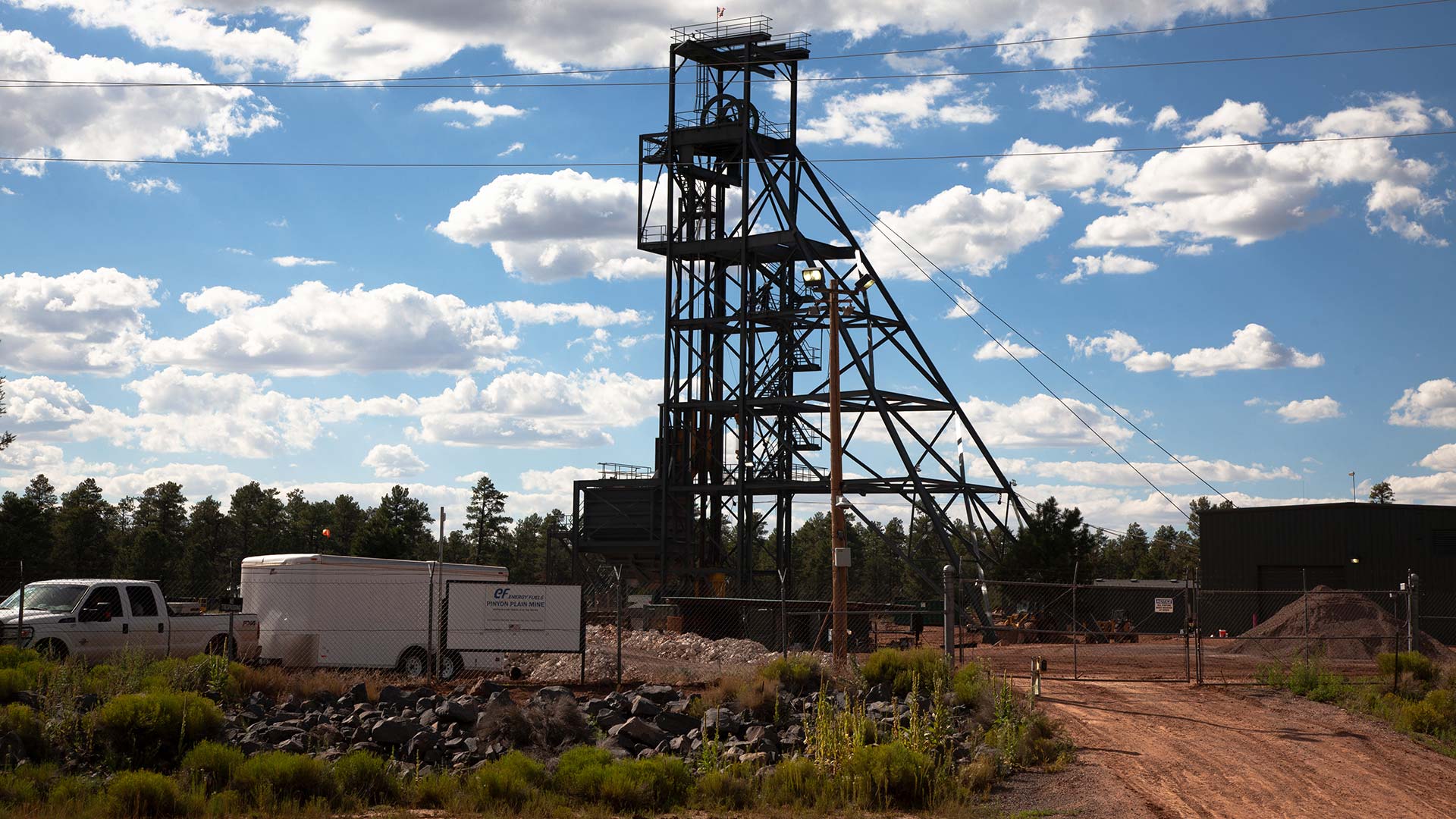 The Pinyon Plain Mine shaft in Coconino County, on Wednesday, Aug. 30. In 2016, the mine shaft punctured a perched aquifer that contained natural levels of uranium, requiring the mining company Energy Fuels to pump water to the surface to an impoundment for treatment.
The Pinyon Plain Mine shaft in Coconino County, on Wednesday, Aug. 30. In 2016, the mine shaft punctured a perched aquifer that contained natural levels of uranium, requiring the mining company Energy Fuels to pump water to the surface to an impoundment for treatment.
Season 2 Episode 10 Rules and Regulations

The responsibility of who regulates our nation’s public lands isn’t always clear. Authority can jump between agencies, leaving some departments with their hands tied. But, for those who have something at stake like the tribal nations, who fight to protect their ancestral homelands, it can seem like the government isn’t doing enough.
A rising concern for tribes like the Havasupai is potential groundwater contamination due to nearby uranium mining within the region. At the forefront of their battle is the 1872 Mining Law– an antiquated federal statute that activists and some lawmakers agree needs reform.
This episode of Tapped was supported by a grant from The Water Desk, an independent journalism initiative based at the University of Colorado Boulder's Center for Environmental Journalism.
Episode transcription
Zac Ziegler: So, one of the things that I passed along to my almost-nine-year-old daughter is a love for the old comic strip Calvin and Hobbes.
I know this seems like a weird place to start a water podcast, but bear with me. Her and I were reading a big collection of all the strips recently, and I came across one that feels so relevant in a couple of ways.
Calvin walks in the door of his house covered in dirt, and his mom tells him to hop in the bath-tub.
Calvin obliges, noting that he is obeying the letter of the law.
Then his mom shouts, "Let's hear some water running!"
Calvin climbs out of the tub, still fully dressed and noting the disappointment that his loophole was spotted.
It's cute to tell stories about the mismatch between the letter and the spirit of a law in terms of a precocious, clever child. I mean, that's much of the plot of the most-watched sitcom on broadcast TV last year, Young Sheldon.
But, those battles lose all of that humor when it's adults doing the same thing, and when we're talking about the possible pollution of a commodity that people need to survive.
Last week, we heard about the Havasupai people's decades-long battle to stop Pinyon Plain, a uranium mine that they say is contaminating their water.
(theme music fades in)
But federal agencies say that the radioactive material of concern continues to be at levels that are safe by law.
This is Tapped, a podcast about water. I’m Zac Ziegler.
The Havasupai have attempted to bring litigation as far as the United States Supreme Court but failed as court after court upheld the mine’s right to operate.
The question still remains…does following the letter of the law adhere to the spirit of the law? And how do rules and regulations, some dating back more than 100 years, affect whether mines like Pinyon Plain get approval?
(theme music fades out)
A-Z-P-M’s diversity, equity and inclusion reporter Paola Rodriguez and environmental reporter Katya Mendoza will take it from here, trying to better understand how a law from the 1800s can still be used to regulate the mining industry.
Paola leads things off.
Paola: For generations, Arizona’s native tribes and environmental groups have fought to protect public lands from economic interests that would threaten their homes…like mining companies. As Carletta Tilousi’s elders would tell her:
CT: “Even though we were removed, forcibly removed from our aboriginal territory, we still have a right to come back to our sacred mountain.”
(western old timey music fades in)
PR: Now, her efforts to unify all of Arizona’s 22 federally recognized tribes have brought the attention needed to protect her homelands.
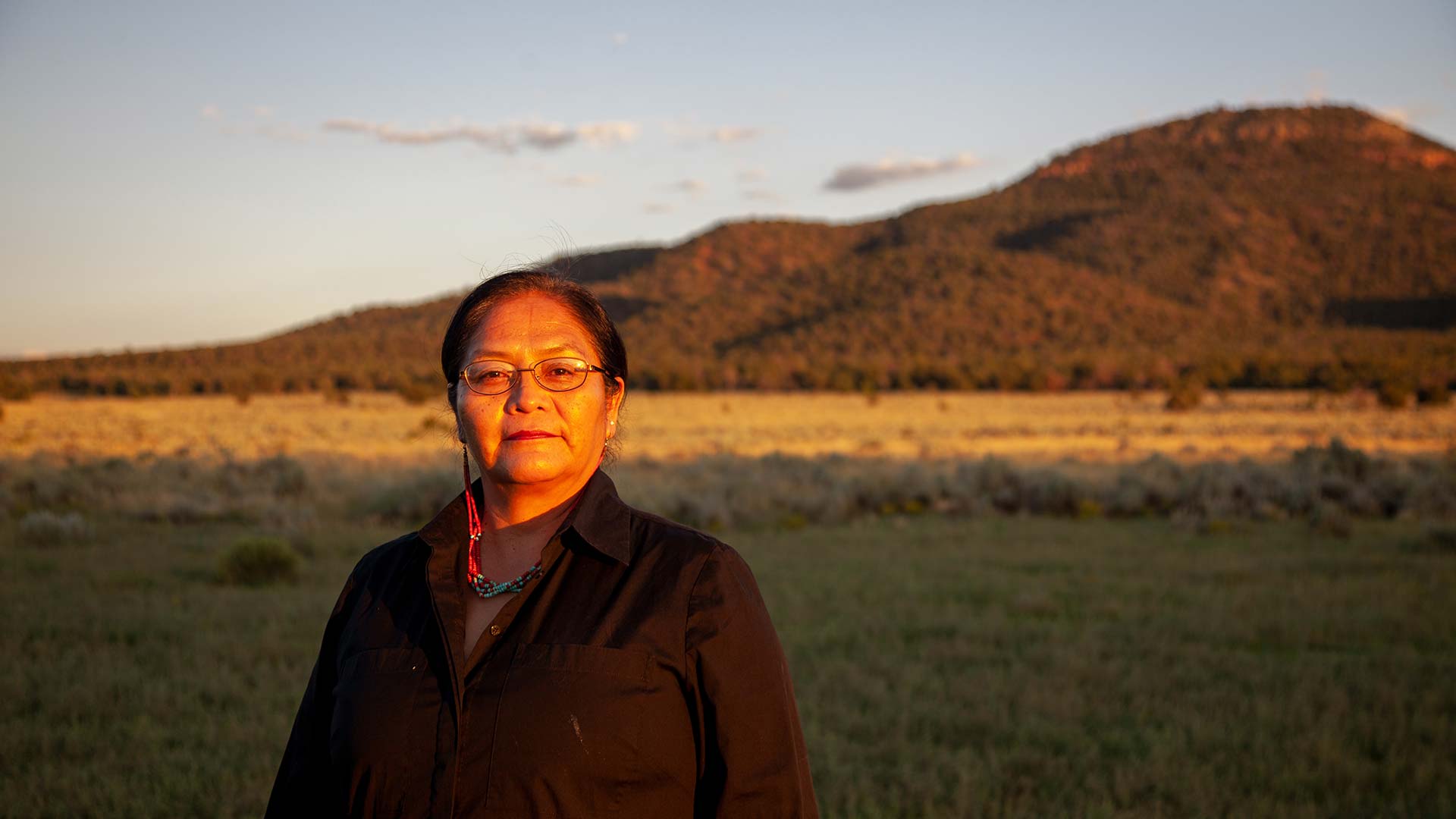 VIEW LARGER Grand Canyon Tribal Coalition Coordinator Carletta Tilousi at Red Butte on Wednesday, Aug. 30. Tilousi has been fighting for environmental justice and sovereignty for the Havasupai Tribe since she was a teenager. She was instrumental in uniting all 22 federally recognized tribes of Arizona, for the historic conservation of nearly one million acres of ancestral land near the Grand Canyon.
VIEW LARGER Grand Canyon Tribal Coalition Coordinator Carletta Tilousi at Red Butte on Wednesday, Aug. 30. Tilousi has been fighting for environmental justice and sovereignty for the Havasupai Tribe since she was a teenager. She was instrumental in uniting all 22 federally recognized tribes of Arizona, for the historic conservation of nearly one million acres of ancestral land near the Grand Canyon. (music fades out)
In August, President Joe Biden designated the Baaj Nwaavjo I’tah Kukveni- Ancestral Footprints of the Grand Canyon National Monument.
That proclamation will now protect nearly one million acres of public lands from any new mining claims–a fight that many of Arizona’s tribal nations have been battling since the beginning of westward settlements.
However, existing mining claims that predate the 2012 mineral withdrawal and two mining operations within the boundaries of the monument, including the long battled Pinyon Plain mine, can still operate.
John Leshy, a former solicitor of the Department of the Interior and retired law professor, says that it is due to “valid existing rights,” a common practice when protections are put in place.
JL: “So if you have a property right already established there, the government can't take it, unless it wants to pay you for it… as I understand it, there are two operations out there or, you know, hardrock mines that have valid existing rights. So you can regulate them, but you can't just say no, you can't stop them unless you want to pay for it because that's their interest is a private property interest at this point.”
PR: But, if these grandfathered mines can continue to exist in the region, then is the fight for protecting public lands over?
For Tilousi, she says no. It’s a two-pronged issue. The first step forward is ensuring a better working relationship between agencies and tribal nations.
PR: Grand Canyon National Monument... it stops all future new claims from being placed. However, Pinyon Plain Mine can still exist. So what's the next part in your all's battle?
CT: Well, the next part is having a seat at the table with the federal agencies and state agencies to work together and protect our sacred places. A lot of these areas that are here, there's a lot of burial sites here. There's also a lot of sweat lodges here that I have personally seen and witnessed and visited. And that's why it needs to be protected…That is the first step of protecting our areas. I think what the President did was put land aside to be protected for all future generations. And that is a very big step for for all the tribes and also for the state and federal agencies. Now they're gonna have to perform to and work with us. And that's never happened. This will be the first time…
PR: Actually, it won’t be the first time.
In order for mines like Pinyon Plain to operate, they must have an Aquifer Protection Permit.
That program is a state level initiative that protects Arizona’s groundwaters since there is no federal equivalent. In order to get an APP, applicants must undergo an extensive review process, including testing for possible groundwater contamination and strategies to prevent drastic environmental impacts.
One of those steps is community collaboration.
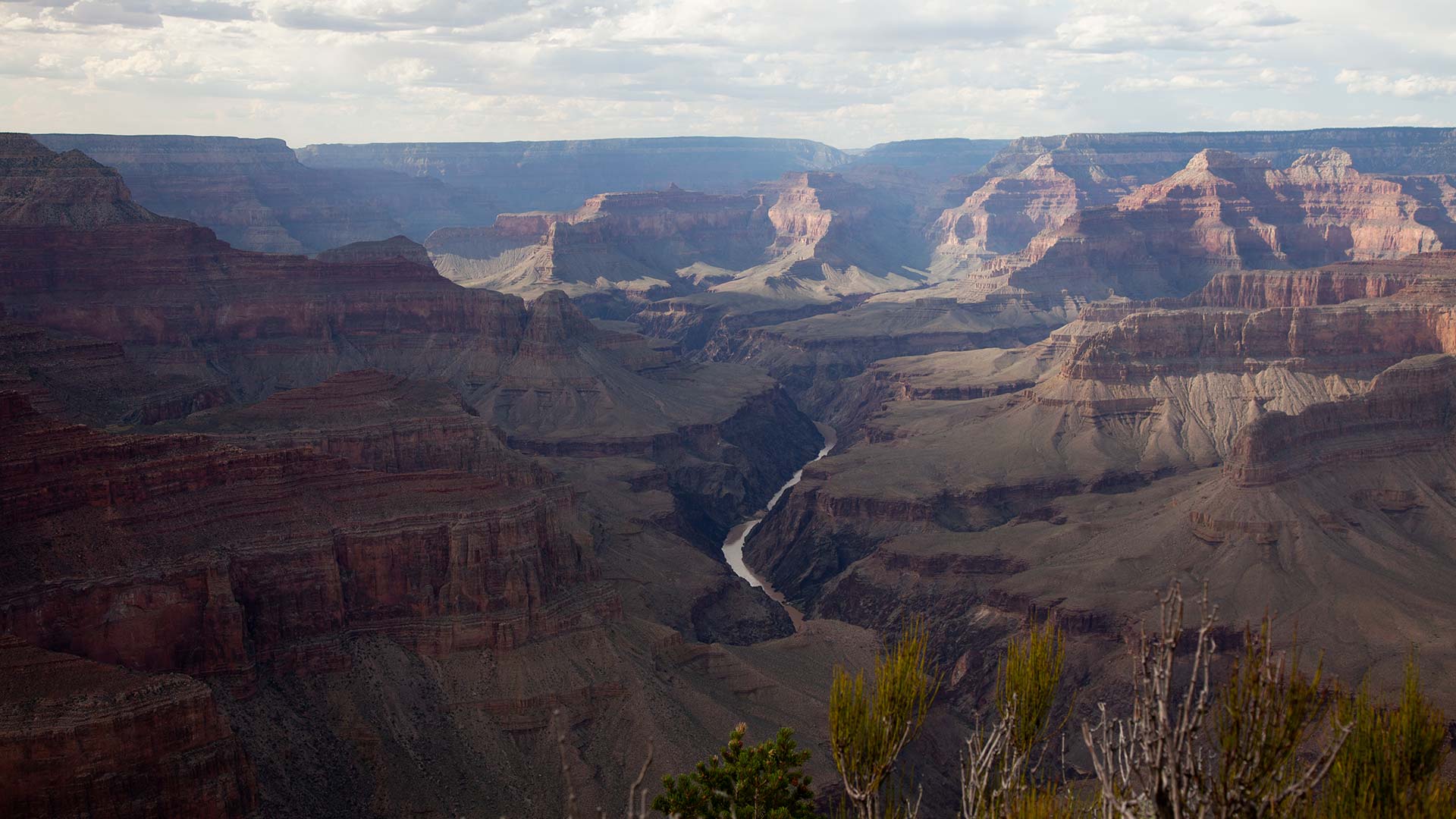 VIEW LARGER The Colorado River in Grand Canyon National Park on Thursday, Aug. 31. 3% of the Colorado River's base flow comes from perennial springs throughout the its watershed.
VIEW LARGER The Colorado River in Grand Canyon National Park on Thursday, Aug. 31. 3% of the Colorado River's base flow comes from perennial springs throughout the its watershed. Especially for mines with significant tribal interest like Pinyon Plain, Water Quality Division Director for the Arizona Department of Environmental Quality Trevor Baggiore says they inform both tribal leadership and their water teams to ensure they are aware of the permitting review process.
TB: We did extensive public engagement including tribal engagement for that general permit coverage together, so the air quality permit and the general permits for water quality, all went through that process together.
PR: It is mandatory for the department to open a 30-day public comment period, where any member of the public, stakeholder, or tribal member can submit comments. For Pinyon Plain Mine, a 45-day public comment period and public hearing led to comments from nearly four thousand individuals.
During the agency’s review process of that mine in 2021, Baggiore says the department dedicated time to reach out and offer formal consultation with Havasupai tribal leaders.
From sending letters to all of Arizona’s federally recognized tribes to virtual consultations, “leader to leader” meetings was a crucial step from the state agency to ensure that collaboration and tribal insight was at the forefront.
(music fades in)
But those who oppose the mine believe that if their insight was considered, then ADEQ would not have permitted an individual aquifer protection permit, solely based on the number concerns revolving around issues like groundwater contamination.
(music fades out)
However, the department still gave the permit. But instead of a general permit, which the mine was previously denied and then approved for, Energy Fuels, the company that operates Pinyon Plain, was given an individual permit to better regulate water quality from the mine’s operations.
The difference between permits, as Baggiore describes it, is like an off-the-shelf suit versus a custom tailored suit.
TB: An individual permit is one that is really the application has much more details in it, because it’s probably either for a more complex facility or facility for which general permits don’t exist for and so then we write this individual permit that has custom tailored conditions for the facility….general permits, they are still aquifer protection permits, but because they’re a very common type of facility, the agency has written a standard set of conditions for it. Whereas the other types of facilities that don’t have general permits or don’t qualify for general permits, they’re still aquifer protection permits, but they are just custom-tailored for the facility.
PR: In fact, Baggiore says the permit that was granted was partially influenced by comments that the agency received from the Havasupai tribe. Because of that, he says they have increased monitoring requirements.
TB: So a facility has an outline…they can put things on the ground in that area, but they can't cause contamination outside of that area. And so we have monitoring wells to ensure that they don't cause contamination or if they do identify any contamination that they take corrective measures to clean it up and prevent it from getting any worse.
PR: As Baggiore says, ADEQ wants to hear from the general public, but…
TB: …by law, if a facility meets APP requirements that are in rule or statute, by law I am required to issue that permit. It’s not discretionary. It’s required by statute if they meet all of the requirements. ADEQ professionals spent over 1000 hours conducting a comprehensive review of all the environmental-related studies and permits, this includes the United States Forest Service documents, as well as legal proceedings and public comments generated over the last 30 years. Based on that extensive review and the extensive public comments, which by the way the Havasupai tribe submitted extensive comments on the public record, ADEQ agreed with the conclusions that were reached, that impacts to groundwater were very, very unlikely and that’s why we issued our individual permit, and I know that’s not always the decision that everybody wanted but when the law is met I’m obligated to issue that permit.
PR: For Grand Canyon Trust Energy Director Amber Reimondo, following the law doesn’t necessarily mean the law is right.
AR: “Their perspective is that they're following the letter of the law, and even if that's the case, the problem is that the law is too permissive. Right? It's not in the favor of the public and what's in the public's best interest. It's very permissive towards mining companies.”
(western music fades in)
PR: And Reimondo is not wrong. The United States has a long history of laws that allow for free and open exploration to mining companies and the system of who regulates what, only complicates when activists work to close these mines.
(western music fades out)
For example, ADEQ only regulates water quality. They do not regulate water quantity…an issue that has remained at the forefront since Energy Fuels pierced an aquifer in 2016, causing over eight million gallons of water to flood into the mine shaft.
Some public comments reflected this concern. They say that the removal of water seeping into the mine shaft can deplete the water resources that feed groundwater-dependent ecosystems such as seeps and springs along the south rim of the Grand Canyon.
ADEQ responded that quote “the APP solely regulates discharges of pollutants to Arizona’s groundwater to protect groundwater quality. As such, ADEQ does not have the legal authority to address concerns regarding groundwater depletion in the Individual APP Permit."
Confusion around who regulates what creates frustrations due to the disconnect of who or what agency is accountable for a mine’s ability to operate.
Research Hydrologist for the United States Geological Survey Fred Tillman, who has been studying groundwater recharge in the Grand Canyon region, understands this.
FT: It is confusing from the inside and I can imagine what it is from the outside. So again, we've spoken several times with the Havasupai tribe, in particular, Carletta Tilousi, and you can see the frustration on their face, because we'll be there sampling, and will we always provide them with results, particularly from Supai Village. And they'll be like, ‘Well, what happens with this?’ And we say, ‘Well, we're just, we're just doing science.’ And it's like, well, this doesn't have anything to do with the regulatory authority, which is the ADEQ or Forest Service. And so I can see their frustration, and I can imagine that they feel like they're getting the runaround. And we have to just explain that we have these very clear lines of not just responsibility, but authority, and we do not do anything regulatory related.
Not only is it hard to pinpoint a lead agency to hold accountable, but as Reimondo said: the laws are too permissive. Which is the second half of the battle for Carletta Tilousi.
CT: …I know a lot of people, even the average citizen, don't understand why public lands are already Why is it not already protected? Well, because there's a mining law called 1872 mining law, which needs to be be changed, you know, that allows international mining companies to come in to our public lands, freely state claims, very little money, stake uranium claims, copper claims, whatever it is, and start raking through this whole land. And strangely enough, those claims happen to be right near our springs, right near our main water source. And so this is just not happening to the Havasupai it's happening to a lot of Indian tribes in Arizona. You know, like the San Carlos Apaches, they've been fighting that for years and, and they deserve some justice. They deserve a seat at the table, as well as, as we are to voice their ideas and how to protect their water and their sacred places. So, the next battle would be to, you know, eliminate the 1872 mining law and hope that Congress members have the courage to do that.
(Western music fades in)
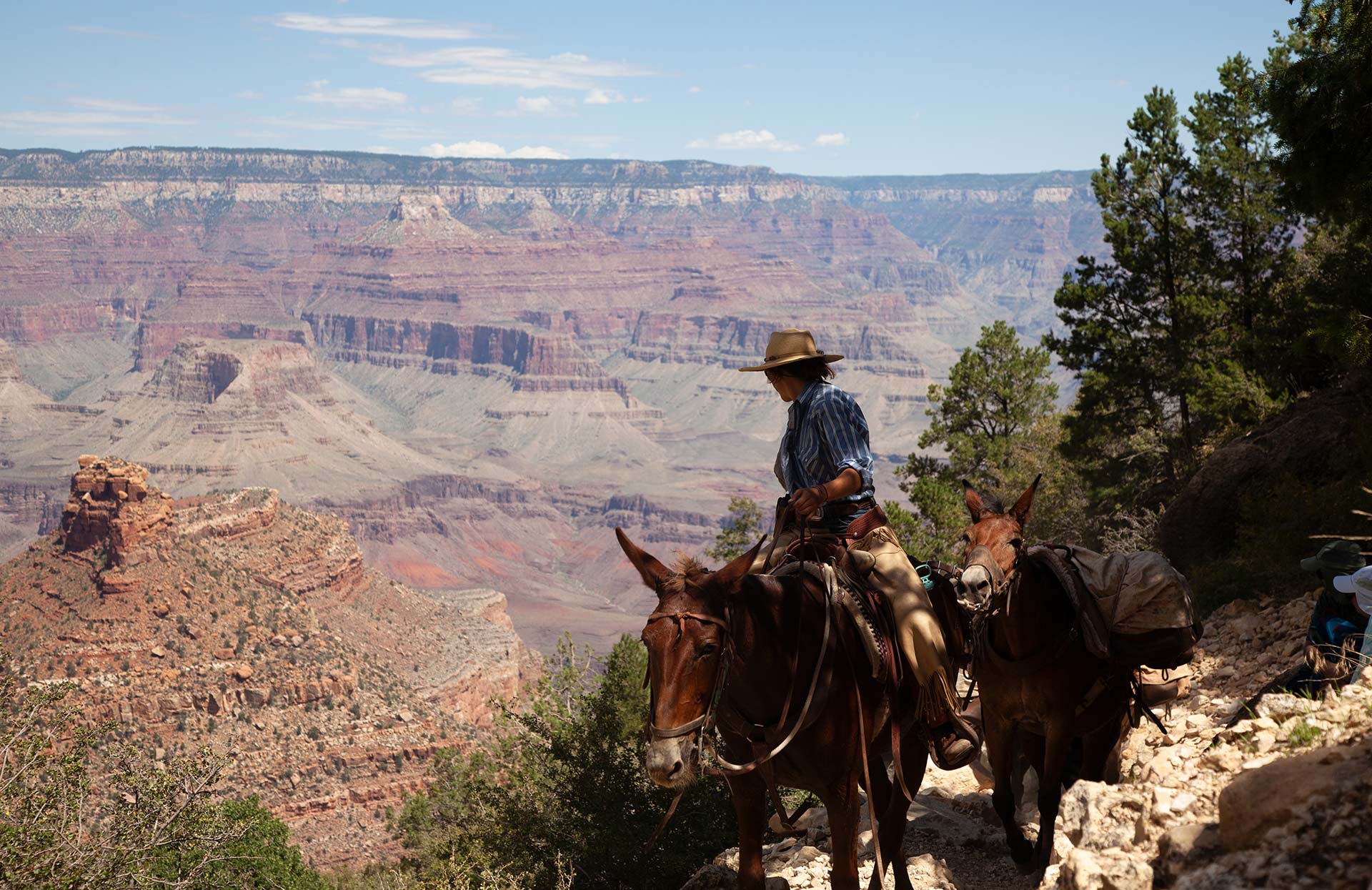 Mules trek up Bright Angel Trail on the south rim of Grand Canyon National Park on Thursday, August 31. Pack mules are emblematic of the American West, and have carried tourists in and out of the canyon since the late 1880s.
Mules trek up Bright Angel Trail on the south rim of Grand Canyon National Park on Thursday, August 31. Pack mules are emblematic of the American West, and have carried tourists in and out of the canyon since the late 1880s.
PR: That law, which dates to the presidency of Ulysses S. Grant in 1872, has been at the center of debate for mining reform. That law “declared all valuable mineral deposits in land belonging to the United States to be free and open to exploration and purchase.
In fact, according to former Department of Interior solicitor and retired law professor John Leshy, it is the last important surviving remnant of nineteenth-century federal land policy. Unlike its “other companions in the great westward movement,” which have “since been repealed”, “much of the mining law's basic architecture remains in place."
JL: Why hasn't it changed? Well, basically the power of the mining industry, in the Congress and inertia, and it's complicated to change it, and there's not agreement on exactly how to change it. And so the kind of disarray of the reformers, plus political inertia and the power of the industry have all combined to to keep it relatively unchanged.
PR: The original piece of legislation lacked environmental protections which eventually led to contaminant issues in the West. Take, for example, mining near the Sierra Nevada Range in California.
JL: Starting in the 1850s, they were using a technique called hydraulic mining, where they took these high-pressure hoses and basically washed the hillsides down and threw mercury on the gravel to leach out the gold. And so to this day, you'll see signs around the San Francisco Bay, they say do not eat the fish that you catch here because it's contaminated by the mercury that was left in the 19th century by the hard rock miners. So environmental impacts go back a long way.
PR: It wasn’t until later that Congress passed the Federal Land Policy Management Act of 1976 that gave regulatory authority to the Bureau of Land Management to “prevent unnecessary or undue degradation of the public lands" and make clear that this also applied to hardrock mineral activity. That act also required systematic planning on public lands and strengthened the authority of the Secretary of the Interior to withdraw federal lands from the operation of the Mining Law.
(music fades in)
Even then, the core of the mining law does not contain environmental protection provisions.
But Reimondo says that’s not its only issue.
(music fades out)
AR: Well, Pinyon Plain Mine has been there since 1986. And they've never developed, why? Because they can't afford to because the price of uranium isn't high enough. So it's not an economically viable mineral resource, unfortunately, because the 1872 mining law and how permissive it is toward mining companies, we lost that lawsuit.
PR: Leshy says that the lawsuit needed to answer one question:
JL: The question comes down to, can they show a valuable mineral deposit? Can they make a profit mining that deposit?
PR: The tribes and environmental organizations argued that sunk costs, a cost that has already been acquired and cannot be recovered, should be considered when taking into account the profitability of uranium mining. The court disagreed.
JL: The Court sided with the company and said, you can ignore the sunk costs. So now, that doesn't, by any means, say that the government can't regulate their operation going forward, can't make sure they don't pollute the water, etc, etc. But it does say they have a property interest here, that can't be taken without compensation. And the government for various reasons, doesn't want to do that. And so that's, that's where we are.
PR: Regardless, mines like Pinyon Plain can continue to operate within the land designation due to their valid existing rights and proof of valuable mineral deposits... all without needing to pay royalties for the federal minerals extracted from public lands.
JL: They are unique in their preferred position here that they pay nothing while the hiker camp or skier or whoever else pay something. I think they're embarrassed by that but negotiating a reform is not that easy.
PR: But, Leshy believes if reform is possible, there are ways to go about it, like:
JL: Keep the existing claim location system, simplify the red tape that's involved for the companies, give the government the clear right to turn down mines that are going to be environmental disasters, strengthen their ability to regulate mining to protect air and water quality and that sort of thing and to involve the tribal nations nearby more in the process. There are things like that you can do. I think that that could be acceptable to everybody if it was if it was well designed. It doesn’t have to be a leasing system. But you know, right now nobody's talking to each other really seriously so we don't know what's going to happen.
PR: The reality is that the Havasupai are not the only tribe fighting for changes to the dated law.
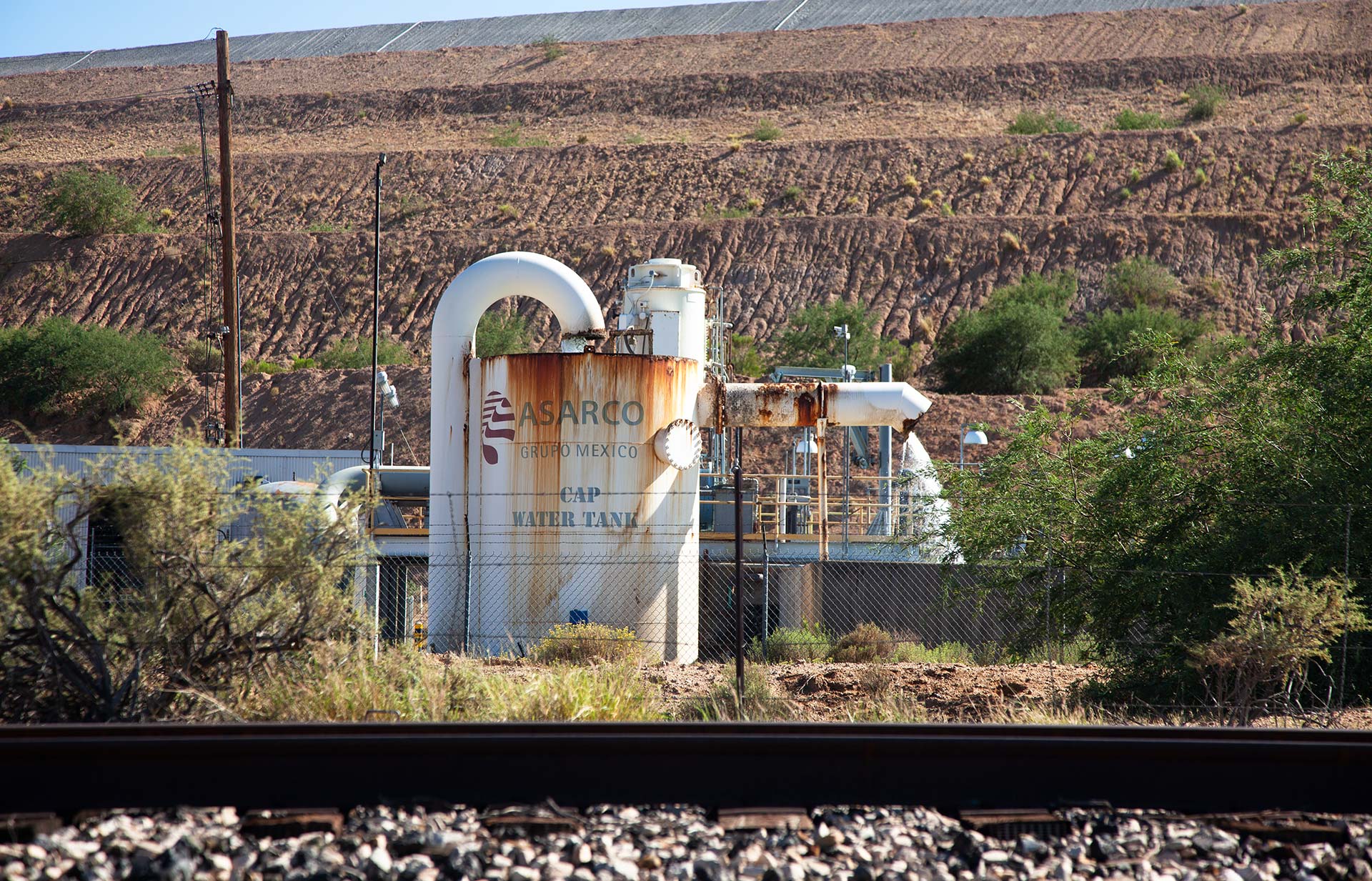 VIEW LARGER A water storage tank for the ASARCO Mission Mine near the San Xavier District of Tohono O'odham Nation on Monday, Sept. 18. The open-pit copper mine is owned and operated by Mexican mining giant, Grupo Mexico. In 2009, a pumping system was installed to utilize Central Arizona Project (CAP) water.
VIEW LARGER A water storage tank for the ASARCO Mission Mine near the San Xavier District of Tohono O'odham Nation on Monday, Sept. 18. The open-pit copper mine is owned and operated by Mexican mining giant, Grupo Mexico. In 2009, a pumping system was installed to utilize Central Arizona Project (CAP) water. In Southern Arizona, the Tohono O’odham nation faced a similar fight with the Rosemont copper mine. In 2022, a federal appeals court blocked the mine’s approval saying there were no valuable minerals. For Chairman of the Nation’s San Xavier District Austin Nunez, this is a fight he knows well.
PR: Is there a way to balance tribal rights and economic interests?
Austin Nunez: Yes, as long as those economic development projects don't harm the land...If there's going to be extraction of it, that there's already a game plan as to how to restore it once you extract whatever minerals you have. And that's what's always been missing in the 1872 Mining Act. And it just gave the mining companies full rein of whatever land they were able to acquire…certainly, of course, the water is the most important part of it as well, to make sure that they don't extract as much water as they're gaining in there, maybe they have to be acquired to find a way to restore that water as well. And also the earth so that they can continue to be healthy and thrive with all the plant life. So, you know, if there's some way to work all those out, I think that it would be a better situation that we currently have.
(piano music fades in)
PR: Since time immemorial, the shared experience between tribes has carried through colonialism, westward expansion and beyond the turn of the century. These issues remain intertwined with the push for tribal sovereignty and the stewardship of their ancestral lands.
The question remains…whose responsibility is it to preserve and protect public lands? And how is that done?
What more can state and federal agencies do when their hands are tied?
And how possible is it for public opinion to sway the legislators who create, regulate and enforce these laws?
These are all questions that converge into what is now the push for a new fight.
ZZ: The vast majority of federal public lands are ancestral homelands to indigenous communities across the country and that rings particularly true in Arizona, a state that's about 40% federal land and includes 22 tribes.
(piano music fades out)
Even after forced removal and displacement from their homelands, the connections that native tribes have with this land never ended.
But these people weren't removed from their ancestral homes for no reason. There was always some resource that white settlers wanted to get their hands on. Maybe it was open space for farming, precious minerals under the surface, or access to the water tribes relied on.
Even still, the tribes that are supposed to have certain water rights on the Colorado are having to fight for a seat at the table as cuts to that river's allocation are discussed.
As the fight on the ground continues, efforts in Congress are making an appearance. In an effort to better elevate the role of Tribal nations and improve the protection of sacred, cultural sites, Southern Arizona Representative and longtime environmental and tribal rights advocate Raul Grijalva introduced two bills that would mend public land management laws that failed to protect tribal governments’ rights and interests.
(theme begins)
Arizona goes to some pretty severe lengths to get water. As we wrap up this season, a big topic of debate going into the next legislative session is how we're going to ensure that future. Will the state spend billions on a pipeline and desalination plants in the Gulf of California? Or will it undertake a massive series of canals that could bring water that would normally cause floods back east into the existing system we have? Or, will we double down on re-use and recycling to better make use of what we already have here?
But, those priorities can get foggy when other interests come into play. And while massive projects like dams help make it possible for millions to live in such an arid climate, the question becomes where does all that time, energy and money spent on water sit when it comes up against another force that makes life here possible?
Tapped is a production of AZPM News.
This episode was written, produced, and mixed by Katya Mendoza and Paola Rodriguez, with editing and mixing help by me, Zac Ziegler.
Our music is by Michael Greenwald.
Thanks to all of the AZPM staff who helped make this season happen: Gary Bell, Christopher Conover, Lisa Coons, Summer Hom, Danyelle Khmara, Katya Mendoza, Paola Rodriguez, AC Swedburg and Desarae Tucker.
Visit our website in the podcast section of azpm.org for pictures, links, and more. Thanks for listening.
We'll see you next season.
(theme music fades out)
This episode of Tapped was supported by a grant from The Water Desk, an independent journalism initiative based at the University of Colorado Boulder's Center for Environmental Journalism.
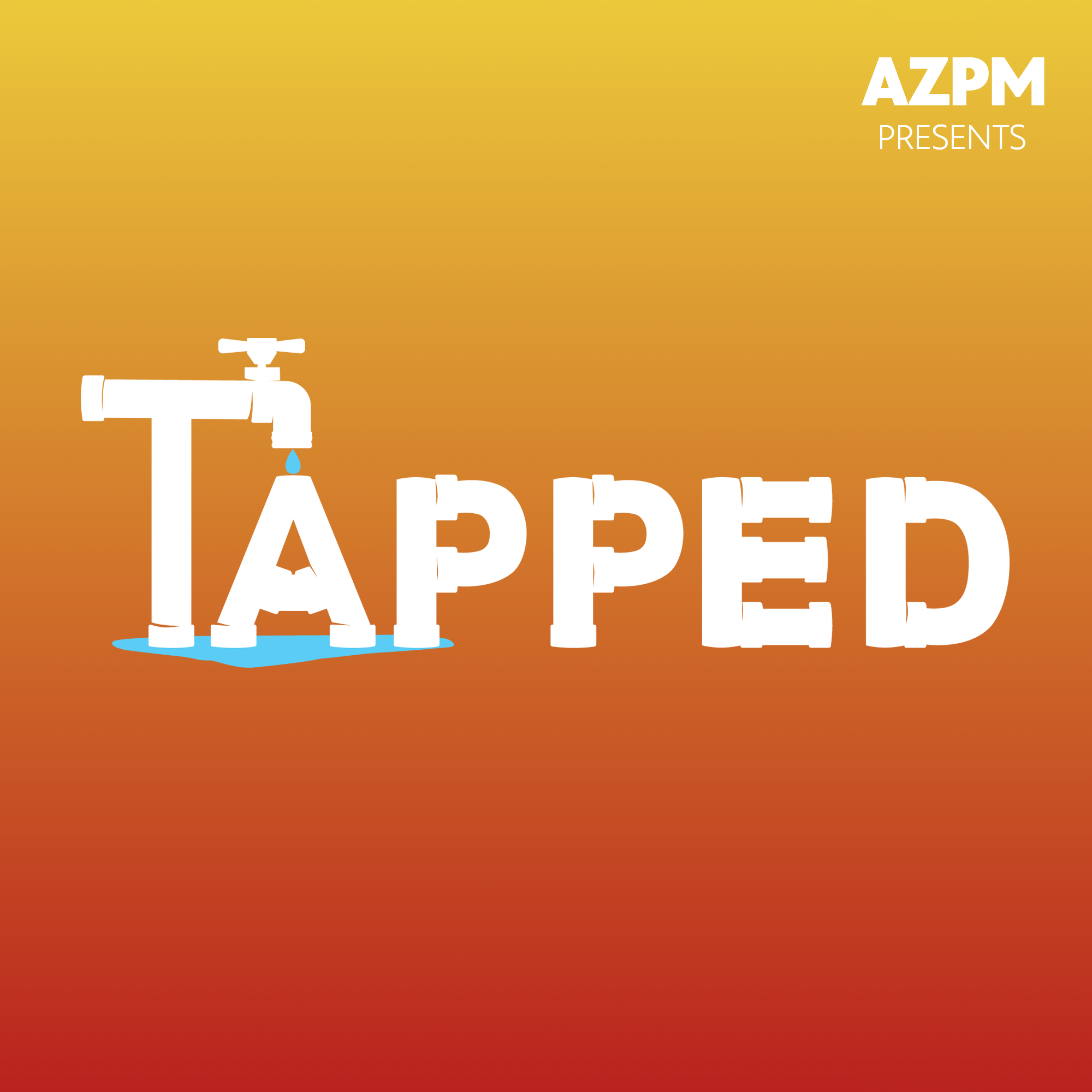




By submitting your comments, you hereby give AZPM the right to post your comments and potentially use them in any other form of media operated by this institution.